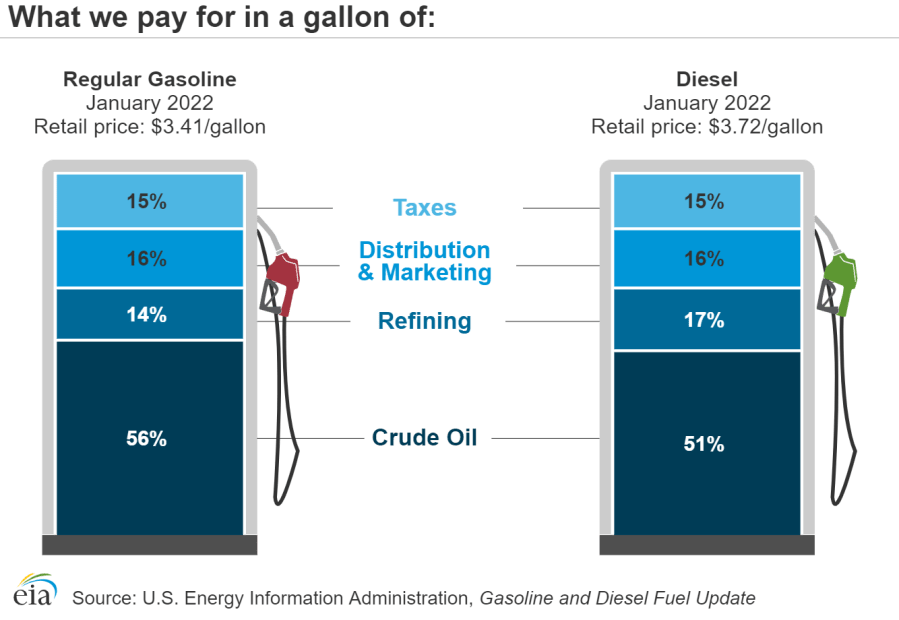TAMPA, Fla. (WFLA) — As the conflict in Ukraine brings economic fluctuation to an even higher level, gas prices are on the rise. Both GasBuddy and AAA said the Russia-Ukraine fight is pushing gas prices up as a result of upheaval and economic uncertainty.
Russia is one of the biggest producers and suppliers of oil in the world, responsible for about 11% of all oil on the planet, according to the U.S. Energy Information Administration. While the conflict between Ukraine and Russia has enveloped the international geopolitical stage, consumers are more focused on prices at the pump, and what it means at home.
To that end, what you pay to fill up your gas tank is affected by more than just prices per barrel. Here’s what goes in to what you pay for gasoline.
The biggest portion of the price is still the cost per barrel. Barrels hold 42 gallons of crude oil. To help calculate prices at the pump, you first need to divide the barrel price by the 42 gallons to get crude price per gallon. Then, you start adding up costs by how much is added for advertising and distribution, refinery, and taxes.
While the U.S. EIA lists gas taxes at 15%, that’s not the rate for every state.
According to the Federation of Tax Administrators, Florida’s fuel tax rate is 33.425. That means for every gallon of gasoline, Florida drivers are paying an extra $0.33425 per gallon, though some prices fluctuate by county due to local fuel taxes.
The Florida Department of Revenue maintains a list every year that’s updated to show the rate in each county, and breaks it down by source of tax.
In the Tampa Bay, fuel tax rates are a little different than the state average.
| County | State Taxes | Inspection Fee | Ninth Cent | Local Option | Additional Local Option | SCETS | County Total | Minimum Local Option | Local Option Above Minimum | Total Tax |
|---|---|---|---|---|---|---|---|---|---|---|
| Citrus | $0.19 | $0.00125 | $0.01 | $0.06 | $0.05 | $0.083 | $0.203 | $0.143 | $0.06 | $0.39425 |
| Hardee | $0.19 | $0.00125 | $0.01 | $0.06 | $0.05 | $0.083 | $0.203 | $0.143 | $0.06 | $0.39425 |
| Hernando | $0.19 | $0.00125 | $0.01 | $0.06 | $0.05 | $0.083 | $0.203 | $0.143 | $0.06 | $0.39425 |
| Highlands | $0.19 | $0.00125 | $0.01 | $0.06 | $0.05 | $0.083 | $0.203 | $0.143 | $0.06 | $0.39425 |
| Hillsborough | $0.19 | $0.00125 | $0.01 | $0.06 | $0.00 | $0.083 | $0.153 | $0.143 | $0.01 | $0.34425 |
| Manatee | $0.19 | $0.00125 | $0.01 | $0.06 | $0.05 | $0.083 | $0.203 | $0.143 | $0.06 | $0.39425 |
| Pasco | $0.19 | $0.00125 | $0.01 | $0.06 | $0.05 | $0.083 | $0.203 | $0.143 | $0.06 | $0.39425 |
| Pinellas | $0.19 | $0.00125 | $0.01 | $0.06 | $0.00 | $0.083 | $0.153 | $0.143 | $0.01 | $0.34425 |
| Polk | $0.19 | $0.00125 | $0.01 | $0.06 | $0.05 | $0.083 | $0.203 | $0.143 | $0.06 | $0.39425 |
| Sarasota | $0.19 | $0.00125 | $0.01 | $0.06 | $0.05 | $0.083 | $0.203 | $0.143 | $0.06 | $0.39245 |
A full list by county is published online by the FLDOR.
Oil refining also adds to the price per gallon for drivers. The U.S. EIA reported a refinery cost average of 14% of prices at the pump. From a 42 gallon barrel of crude oil, between 19 and 20 gallons becomes the fuel that goes into most cars, according to the administration. From what’s left of a barrel, 11 to 13 gallons become diesel fuel, and the last 3 or 4 gallons are used for jet fuel.
The last chunk of pump prices is for distribution and marketing, or advertisement and delivery. Gasoline must be sold and transported to gas stations before it can reach consumers. The U.S. EIA reports distribution and marketing makes up 16% of the final cost of gas per gallon.
While prices are rising across the country, AAA’s gas price tracker shows Florida still isn’t the most expensive state to fill up in the U.S., and the state gas price average is actually lower than the national one by seven cents at $3.50 per gallon. Currently, the highest gas prices in the country are still in California, where prices are averaged at $4.79 per gallon.








